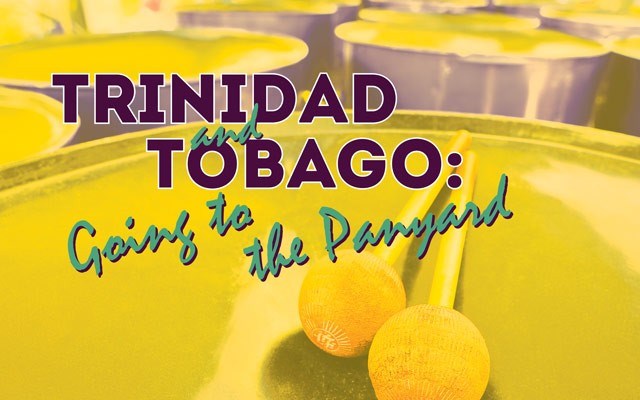I'd never heard of a panyard before visiting Trinidad and Tobago. But what did I know about island customs? I didn't even arrive pronouncing the country's name right. A customs inspector quickly corrected my pronunciation of Tobago's second syllable from short "o" sound to long "a."
Another lesson for me: The instrument played at a panyard is a steel pan, not a steel drum. On a warm September evening in Port of Spain, I ventured downtown to hear The Invaders play that iconic Trinidadian instrument.
Walk through the front gate and you're in the panyard, which is just like it sounds, a large yard with the whole steelpan orchestra set up. Since this consists of about 20 pans on stands — plus groin-high barrels too big to wrap your arms around — it's quickly obvious why a panyard is necessary. Plus you need plenty of space for dancing and a makeshift bar. The whole scene felt casual and exuberant. Then the musicians started playing.
That's when things got loud. And really happy. Can a steelband sound sad? From "Rock the Boat" to "Boogie Woogie Bugle Boy," the Invaders delivered a nonstop party.
Since I was with a tourist group, one of the leaders gave us a short talk on steelpan history. Then he said if we wanted to try our hand at the pan, we could approach a member and he or she would give us a quick lesson. I'd been watching a woman playing the big bass pans, a set of six that formed a hip-high semicircle around her. Up close, I could see that each pan has round divots that play different notes. She introduced herself as Glenda and gamely taught me to play the bass part of the song "Tequila." Once all the members of my group were deemed proficient, we proceeded to play perhaps history's longest rendition of the song, a fate no audience should have to endure. Our teachers patiently encouraged us.
Steelpan History
Steelbands were not always so friendly to tourists, or to anyone else.
The instrument evolved out of makeshift junk like trash cans, scrap metal and 55-gallon oil drums discarded by Trinidad's refineries. This was music from the streets. Trinidad's upper class considered it ghetto. It didn't help that criminals seemed to love steelbands, and performances often turned into brawls.
Over time, Trinis refined both the instrument and their behaviour, although the latter took quite a while. They soon noticed that beating on metal changed the way it sounded. Winston "Spree" Simon, often called "The Godfather of Pan," is generally credited with inventing a pan with eight distinct notes sometime around 1942. But the music still attracted rough characters, which explains why they had tough names like Renegades, Hell Yard and Invaders.
The Invaders began as the Oval Boys in 1937. After watching the 1942 British war movie "The Night Invader," they changed their name. During the 1940s, the Invaders were especially prone to violent clashes with rival bands.
The Modern Pan Scene
As far as I could tell, the Invaders have left combat behind. Glenda told me members range from 17 to 70 years old, and many are female. They practice a few hours a week for the joy of it. And, like all the Trinidadians and Tobagans I met, they seem very proud of their culture and their official symbols, be it the national bird (scarlet ibis), the national flower (chaconia), or the national instrument (steelpan).
Currently, Trinidad and Tobago has more than 100 steelbands. These range in size from five to 25 musicians. But during Carnival they swell to 50 to 120 players. About 10 panyards in Trinidad and five in Tobago are open to visitors year-round.
People hire steelbands for private functions, especially weddings. Since steelbands are cumbersome, hard to transport and composed of many musicians, hiring one can easily cost about $16,000.
A 1986 Act of Parliament formed PanTrinbago, which serves as both a cultural organization and a union representing steelpan players. PanTrinbago has raised the stature of steelbands. People all over the world are familiar with the instrument and have heard recordings. But recordings don't match experiencing a steelband in person, and seeing the joyful way the musicians move. This music embodies happiness.
Pick up Pique next week for Part 2 of Teresa's series on Trinidad and Tobago.




